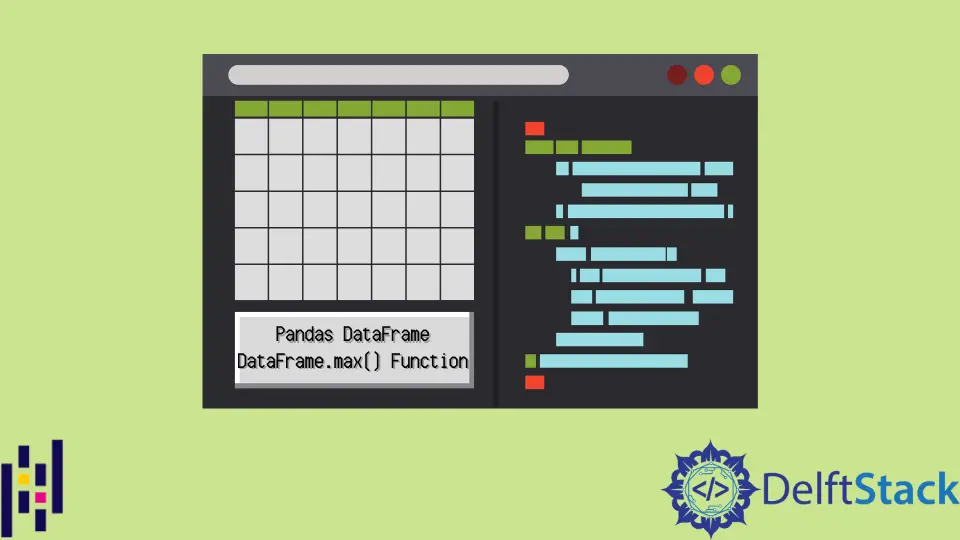Pandas DataFrame DataFrame.max() 函式
-
pandas.DataFrame.max()語法 -
示例程式碼:
DataFrame.max()方法沿列軸尋找最大值 -
示例程式碼:
DataFrame.max()方法沿行軸尋找最大值 -
示例程式碼:
DataFrame.max()方法尋找最大值,忽略NaN值

Python Pandas DataFrame.max() 函式計算 DataFrame 物件在指定軸上的最大值。
pandas.DataFrame.max() 語法
DataFrame.max(axis=None, skipna=None, level=None, numeric_only=None, **kwargs)
引數
axis |
沿行(axis=0)或列(axis=1)求最大值 |
skipna |
布林型。排除 NaN 值(skipna=True)或包含 NaN 值(skipna=False) |
level |
如果軸為 MultiIndex,則沿特定級別求最大值 |
numeric_only |
布林型。對於 numeric_only=True,只包括 float、int 和 boolean 列 |
**kwargs |
函式的附加關鍵字引數 |
返回值
如果沒有指定 level,則返回請求軸的最大值的 Series,否則返回最大值的 DataFrame。
示例程式碼:DataFrame.max() 方法沿列軸尋找最大值
import pandas as pd
df = pd.DataFrame({'X': [1, 2, 2, 3],
'Y': [4, 3, 8, 4]})
print("DataFrame:")
print(df)
maxs = df.max()
print("Max of Each Column:")
print(maxs)
輸出:
DataFrame:
X Y
0 1 4
1 2 3
2 2 8
3 3 4
Max of Each Column:
X 3
Y 8
dtype: int64
它得到了 X 和 Y 兩列的最大值,最後返回一個 Series 物件,其中包含每列的最大值。
在 Pandas 中,要找到 DataFrame 中某一列的最大值,我們只呼叫該列的 max() 函式。
import pandas as pd
df = pd.DataFrame({'X': [1, 2, 2, 3],
'Y': [4, 3, 8, 4]})
print("DataFrame:")
print(df)
maxs = df["X"].max()
print("Max of Each Column:")
print(maxs)
輸出:
DataFrame:
X Y
0 1 4
1 2 3
2 2 8
3 3 4
Max of Each Column:
3
它只給出 DataFrame 中 X 列的最大值。
示例程式碼: DataFrame.max() 方法沿行軸尋找最大值
import pandas as pd
df = pd.DataFrame({'X': [1, 2, 7, 5, 10],
'Y': [4, 3, 8, 2, 9],
'Z': [2, 7, 6, 10, 5]})
print("DataFrame:")
print(df)
maxs=df.max(axis=1)
print("Max of Each Row:")
print(maxs)
輸出:
DataFrame:
X Y Z
0 1 4 2
1 2 3 7
2 7 8 6
3 5 2 10
4 10 9 5
Max of Each Row:
0 4
1 7
2 8
3 10
4 10
dtype: int64
它計算所有行的最大值,最後返回一個包含每行最大值的 Series 物件。
示例程式碼:DataFrame.max() 方法尋找最大值,忽略 NaN 值
我們使用 skipna 引數的預設值,即 skipna=True 沿指定的軸找到 DataFrame 的最大值,忽略 NaN 值。
import pandas as pd
df = pd.DataFrame({'X': [1, 2, None, 3],
'Y': [4, 3, 7, 4]})
print("DataFrame:")
print(df)
maxs=df.max(skipna=True)
print("Max of Columns")
print(maxs)
輸出:
DataFrame:
X Y
0 1.0 4.0
1 2.0 3.0
2 NaN 7.0
3 3.0 4.0
Max of Columns
X 3.0
Y 7.0
dtype: float64
如果我們設定 skipna=True,它將忽略 DataFrame 中的 NaN。它允許我們沿列軸計算 DataFrame 的最大值,忽略 NaN 值。
import pandas as pd
df = pd.DataFrame({'X': [1, 2, None, 3],
'Y': [4, 3, 7, 4]})
print("DataFrame:")
print(df)
maxs=df.max(skipna=False)
print("Max of Columns")
print(maxs)
輸出:
DataFrame:
X Y
0 1.0 4
1 2.0 3
2 NaN 7
3 3.0 4
Max of Columns
X NaN
Y 7.0
dtype: float64
這裡,我們得到了列 X 的最大值為 NaN,因為列 X 中存在 NaN 值。
Founder of DelftStack.com. Jinku has worked in the robotics and automotive industries for over 8 years. He sharpened his coding skills when he needed to do the automatic testing, data collection from remote servers and report creation from the endurance test. He is from an electrical/electronics engineering background but has expanded his interest to embedded electronics, embedded programming and front-/back-end programming.
LinkedIn